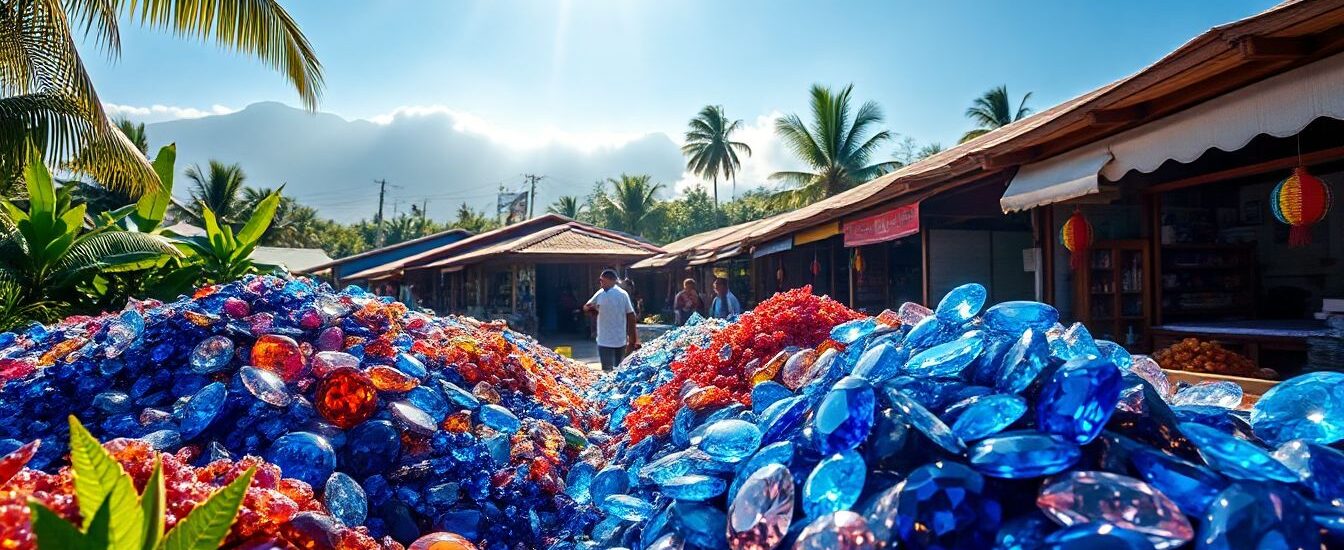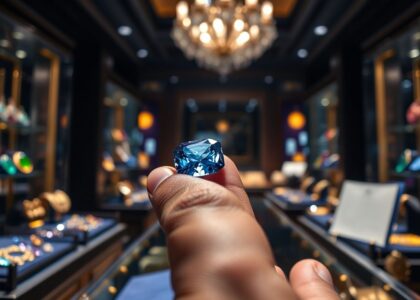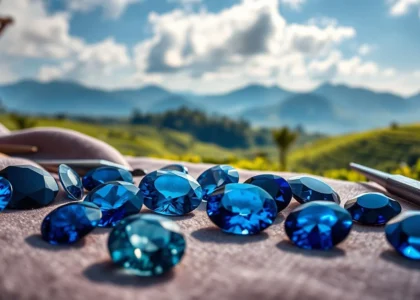Introduction
Sri Lanka has long been famous for producing some of the world’s finest sapphires. These gems have captured the attention of collectors and jewelers across the globe. Sri Lankan sapphires are prized for their quality, vibrant colors, and rich history. They play a big role in the country’s economy and exports.
In this article, you’ll learn about the main sapphire types found in Sri Lanka. You’ll also discover what makes each variety special, plus how its value is determined. Whether you’re a collector or just want to understand more about these gems, this guide will help you see why Sri Lanka’s sapphires are so highly regarded.
Sri Lanka’s Geographical and Geological Context for Sapphire Formation
Geological conditions conducive to sapphire deposits
Sri Lanka sits on a land rich in minerals. Its volcanic past created perfect conditions for sapphires to form. The country’s alluvial soils contain tiny mineral particles that are ideal for sapphire deposits. Many sapphires come from riverbeds and loose sediments washed down from rocky mountains.
Two main sources of sapphires are found in Sri Lanka: the primary host rocks and the secondary alluvial deposits. These rocks contain crystals of sapphire that have been weathered and transported over thousands of years.
Historical significance of sapphire mining in Sri Lanka
People have mined sapphires in Sri Lanka for centuries. The earliest records date back over 2,000 years. Mining grew steadily during the colonial era and remains crucial today. The best-known regions for sapphire mining are Ratnapura, Elahera, and Kandy.
Sapphires brought wealth to local communities and helped build Sri Lanka’s reputation as a top gemstone producer. Today, the country continues to be a major supplier of high-quality sapphires worldwide.
Main Varieties of Sapphires Found in Sri Lanka
Ceylon Sapphires: The Classic Blue
Known worldwide, Ceylon sapphires are famous for their clear, sky-blue color. This hue resembles a cornflower or robin’s egg. They often have high clarity, making them very popular in rings and jewelry.
Ceylon sapphires are generally large, with well-cut stones showcasing their vibrant hue. The light transmits beautifully through these gems, giving them a soft glow. Their gentle blue is easy to recognize and highly sought after.
Padparadscha Sapphires: The Rare Oriental Pink-Orange
Padparadscha sapphires are among the rarest varieties. Their name means “lotus flower” in Sinhalese. These sapphires feature a delicate blend of pink, orange, and sometimes a hint of purple.
Because of their unique color and scarcity, Padparadscha sapphires fetch much higher prices. They are loved for their gentle pastel shades and are often used in delicate, elegant jewelry.
Yellow Sapphires: Bright and Vibrant
Yellow sapphires in Sri Lanka come in a wide range of shades—from pale butter to deep gold. These stones are popular for their cheerful color and versatility. They can brighten up any jewelry piece and are often used as an alternative to more expensive diamonds.
Their sunny hues make yellow sapphires favorites among designers and buyers alike. High-quality yellow stones boast good transparency and even color saturation.
White Sapphires: The Clear Alternative
White sapphires look similar to diamonds but are usually more affordable. They have a clear, colorless appearance and are valued for their brilliance.
Many choose white sapphires for engagement rings or as a gemstone substitute. They can sometimes have internal flaws, but when well-cut, they sparkle beautifully. The demand for white sapphires continues to grow, especially in markets where cost matters.
Other Varieties and Least Common Types
Sri Lanka also produces a few rarer sapphire types. These include:
- Green sapphires: Usually treated to deepen their color, green sapphires are less common in their natural state. Their shades range from pale mint to deep forest green.
- Purple sapphires: These are often found with a violet hue, especially in mixed-color clusters. Their value depends heavily on clarity and hue intensity.
- Partially colored sapphires: Some stones display only certain parts with vibrant color, while others are more subdued. These can be unique but usually carry less value unless especially rare.
Factors That Influence Sapphire Value in Sri Lanka
Color Intensity and Hue
The most crucial factor is color. The most valuable sapphires display a vivid, saturated hue. Light or dull colors decrease worth. Deep, vibrant blue or rich pinks often sell at premium prices.
Experts say that perfect color for a blue Ceylon sapphire is a medium to medium-dark hue with good saturation. Rarer hues like pink-orange pads or intense green also fetch high prices.
Clarity and Transparency
Clarity measures how many internal flaws or inclusions a gemstone has. Clearer sapphires are generally more desirable, especially for larger stones. Tiny inclusions may not affect the beauty much but large flaws cut down their value.
Evaluating clarity involves looking at the stone under good light. It’s essential for collectors to consider how inclusions impact the gem’s brilliance.
Carat Weight and Size
Big sapphires command higher prices per carat. Large, high-quality sapphires of several dozen carats are rare and valuable. Sri Lanka has produced some famous large sapphires that sold for millions.
A few notable examples include sapphires over 100 carats that have sold at auction for record-breaking prices.
Cut and Shape
Proper cutting enhances a sapphire’s color and brilliance. Popular cuts like oval, cushion, and round are common in Sri Lanka. Skilled gem cutters can maximize the gem’s shine and hide flaws.
Shape matters because it influences how the light plays through the stone. Well-cut sapphires look more lively and attractive.
Treatment and Enhancements
Most sapphires undergo treatments to improve color or clarity. Heat treatment is the most common and accepted in the industry. Coatings or dyes are less desirable and often reduce value.
Buyers should always ask for certification confirming if a sapphire is treated. Untreated, natural sapphires are more valuable and rare.
Origin Certification and Ethical Sourcing
Authenticity matters. Reputable labs like GIA or SSEF provide certificates stating a sapphire’s origin and treatment status.
Ethically mined sapphires are becoming more popular. Buyers want to ensure the stones come from responsible sources. Certification and transparent sourcing boost confidence and price.
The Market and Pricing of Sri Lankan Sapphires
Current global demand for Sri Lankan sapphires
The demand for Sri Lankan sapphires remains strong worldwide. Countries like the US, China, India, and Japan import a healthy amount of these gems.
Exports of sapphires contribute significantly to Sri Lanka’s economy. The country’s reputation as a top sapphire producer continues to grow.
Pricing Trends and Auction Results
Prices vary based on quality, size, and rarity. Generally, a good quality blue Ceylon sapphire can retail from $500 to over $10,000 per carat.
Special stones, especially large or rare colored sapphires, fetch millions at auction. Recent record-breaking sales have highlighted the value of Sri Lanka’s most exceptional sapphires.
Tips for Buyers and Collectors
Always seek certification from trusted labs. Get a clear assessment of the sapphire’s quality. Look for a reputable jeweler who understands the gemstone’s origin and treatment.
Be patient and compare different stones before making a purchase. Investing in sapphires with high clarity, vivid color, and good size can pay off in the long run.
Investing in Sri Lankan Sapphires
Sapphires can be a smart long-term investment if chosen carefully. Look for gems that have a high level of purity, rare colors, and good provenance.
Research market trends and auction results. Select stones that show potential to appreciate over time. Proper storage and documentation will help increase their value in the future.
Conclusion
Sri Lanka offers a spectacular variety of sapphires—each with unique colors and characters. From classic blue Ceylon sapphires to rare Padparadscha pink-orange stones, the selection is impressive.
Understanding what influences sapphire value helps you make smarter choices—whether buying for investment or personal use. High color saturation, clarity, size, and genuine origin are key to getting the best value.
If you plan to buy sapphires from Sri Lanka, always work with reputable sources, ask for certifications, and stay informed. Those strategies will help you find authentic, stunning sapphires that can hold or grow their worth over time.






